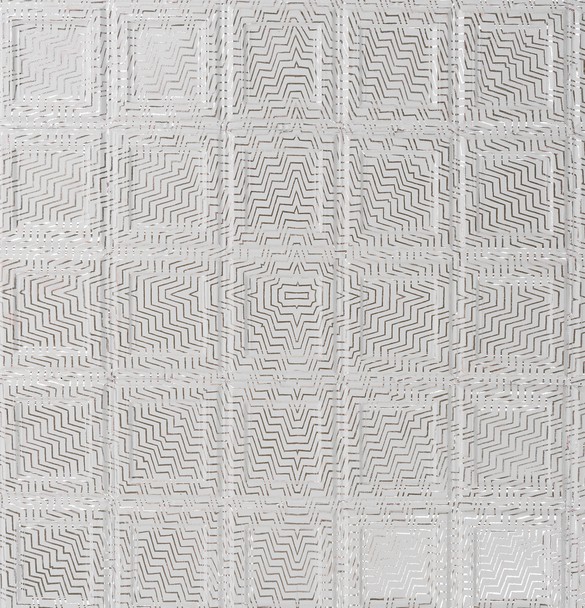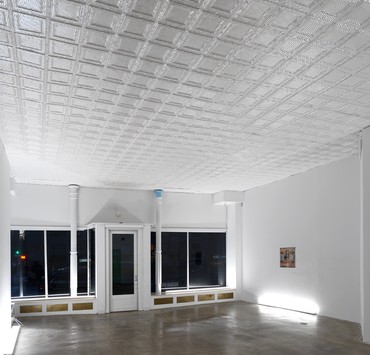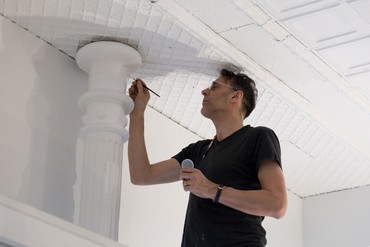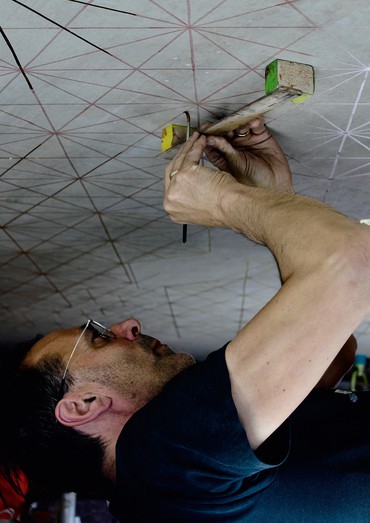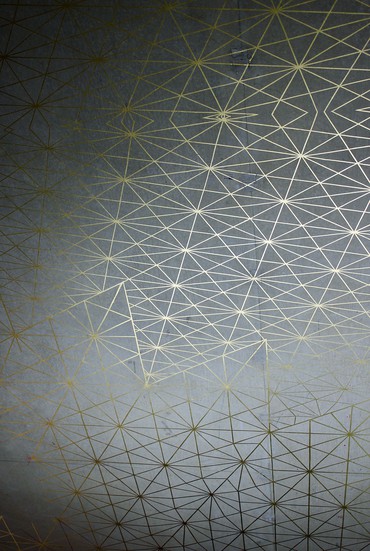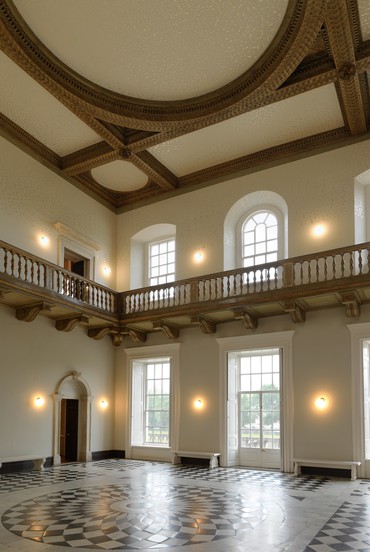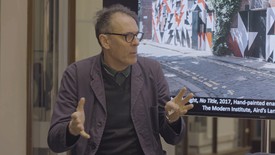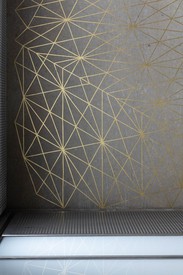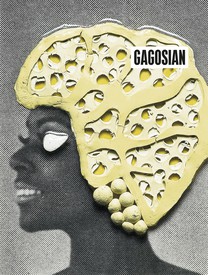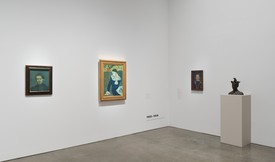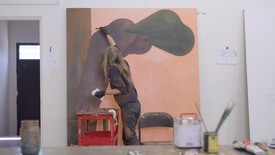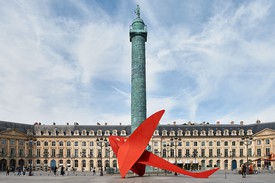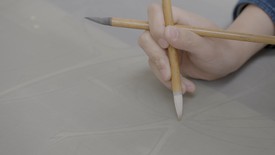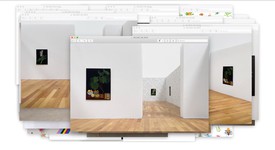
Kay Pallister joined Gagosian in New York in 1997. With a postgraduate degree in curatorial practice from De Appel, Amsterdam, she has worked with several artists on exhibitions, productions, public artworks, and publications for more than twenty years, both within the gallery and with nonprofit organizations. She is currently working on a monograph devoted to the work of Richard Wright.
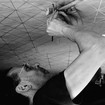
Richard Wright is best-known for his painted and gilded works applied directly to walls and ceilings. His pieces, which are often transient, charge the spaces they inhabit with a range of forms, from baroque ornamentation to constructivist patterns. In recent years he has produced commissions for numerous public spaces and institutions, including the Tottenham Court Road (Elizabeth Line) station, London (2018), the Queen’s House, Greenwich, London (2016), and the Rijksmuseum, Amsterdam (2012). Photo: David Ersser
Kay Pallister Richard, when you’re thinking about what kind of work to make for a place, do you think differently about it if it’s a temporary work, as the majority of your wall and ceiling works have been, than you do if it’s to be a permanent piece? Do you feel that the demands are different, and are there differences in your techniques?
Richard Wright One of the positive things about temporary work is that there is a degree of forgiveness. The work disappears and this allows you to take a risk. I think that it’s a little different with a permanent work, with which the imaginary future of the work might have to be considered, both from a technical and an emotive point of view. In this latest show at Gagosian, for example, I’ve painted in gouache on one of the pillars. While gouache can survive, it’s not the ideal material to think about exposing to the environment for a long period of time.
KPIs that because it would fade?
RWPotentially fade, but it’s also a reversible material; contact with moisture will turn it back into what it was. Which I love about it, actually—I love that you can almost literally put it back in the jar. Gouache has a special quality that’s hard to replicate, but I wouldn’t so readily use it for a permanent commission.
KPAnd what about the silver you’ve used in this exhibition?
RWSilver is also a material that is subject to mutation. It will oxidize and change, which I find interesting; in fact I would love to see the work do that, to see the silver gradually fade away and become dark. Silver has this special coldness that’s slightly different from a material like palladium, which might be its equivalent. If I were doing a work like this in a more permanent setting, I’d be tempted to use palladium for its stability, but then I would lose out on this specific feel.
KPWhen you’re invited to make an exhibition, or a work like the one you’ve just finished at Park and 75, what is it about a space that determines where you’re going to locate a piece?
RWThat’s quite a difficult question to answer. I always want to bring some special quality out of the space, so in some ways the work is already there. Sometimes I might have to look quite hard to find it and there is a sense that ideas appear out of nowhere. But there is also an accumulation of material that I’m working with at a particular time. I have attractions, ideas that circulate in my mind. I draw every day, and there’s a sense in which I’m actually looking for a place for these thoughts. Sometimes it just happens; two things come together, something that you’re working with and something that is there in the situation. Perhaps one brings out the other. There are other times when it’s more difficult and when you have to make more effort to find some sort of coexistence with the space. For me, this is a material dialogue, between a built world in which the work is placed and a more fragile world of thoughts. Sometimes it is a sympathy and sometimes it is more antagonistic. In each case thoughts are deflected by the material. You can see it in the piece on the ceiling: the intentions of the work are perhaps more visible on the wall, where it’s flat, than on the more disrupted surface of the ceiling. You think you have an idea but the material has other ideas. In the end the work emerges out of this, so it’s hard to say exactly where that idea starts. Perhaps the idea is really an action.
Considering the space at Park and 75 at the beginning, I immediately thought I would do something with the pillars. Somehow they drew to mind more ancient situations and I began to think about Egyptian architecture and wall painting. I didn’t do so much with them in the end, but perhaps other thoughts came from this beginning . . .
KPI’ve noticed, when visiting places with you, that you appreciate artists and creators of all kinds on a really sublime level. From architects to stone masons, you’re clearly very moved by the devotion that’s shown by the various makers involved.
RWI think devotion is a very good word, actually. It’s like Donald Judd said: “We go into the cathedral and we thank God instead of thanking the architect.” I am interested in touch and how directly working with materials gives the fabric of our situation a presence; it imbues it with affection, with love. Something is drawn to it in this engagement with matter. Whether that’s just putting some flowers in a vase or whether it’s moving two books together on a table and just feeling that the way that they converse with each other makes you feel more relaxed, or happy, or simply closer to reality. It’s these tiny little things that happen when things speak to each other that bring in this closeness, this proximity of the world. It’s a kind of attention. In architecture, these moments are everywhere. It’s how the floor meets the wall and how the wall meets the ceiling. I’m very much drawn to those points where two elements come together. It is there, where a conversation has already started, that some sense of meaning begins to appear. Part of the thing is just to become involved in that conversation. The ceiling in this case was just such a situation. Again, it was unusual to see something like that in a gallery space and it just had to be a work really, it had to be, it already was a work. I looked at a lot of different possibilities, some of which were much more aligned with the structure, and wanted to be a grid. But, in the end, I was drawn toward something that slightly resisted, a kind of disruption, a disruptive relationship, it’s like a conflict, even, between the two things. And, of course, then you think,“Was that the right decision?”
KPIt’s tremendously complex work that you do, and to deliver it in a specific amount of time is an awful lot of pressure. I’ve heard you say before that time is the most important material—you’ve admitted that quite often you get to the deadline, the opening of the show, for instance, and you say, “If only I had another day.” But what do you think would change in the work if you had this extra time? Or is it a kind of separation anxiety?
RWTime is what the work is made of. Time is all you’ve got, and all you can’t get back when you’ve spent it. I’m acutely aware of that when I’m making things. It is that precious material that’s constantly being used up as you work. In some senses, that situation informs your decisions. This is a live event, time limits what you can do, but that pressure stimulates a kind of necessity and focus. It’s not always fun but it’s where the work comes from. If I had more time I guess I’d probably have to create more pressure, I’d have to do more. It would be a completely different work.
KPIn these periods when you’re on-site and you’re working long hours every single day, focused on delivering this idea to that space, your personal commitment to the work is incredibly deep; this idea of devotion is really part of how your work comes out. It couldn’t happen any other way without your 110 percent commitment to the practice. It makes me wonder what remains for future generations to appreciate. Do you ever feel concern that there won’t be very many remains?
RWI think at the beginning I was very attracted to the idea that there wouldn’t be anything left. I think this dematerialization was part of my motivation, really. I quite liked the idea that it was like playing music, which disappears into the air. I still feel that way, but I do have moments sometimes of reflecting that it can’t be done again. But this sense of loss, if you like, is actually connected to heightening the moment of delay, the moment of being here. I’m not sure where that leaves the future.
KPIn recent years you’ve won commissions and been invited to do large scale works in public settings that will be as permanent as one might conceive. The Queen’s House in Greenwich, a four-hundred-year-old building by Inigo Jones, and the Tottenham Court Road Crossrail station on the Elizabeth Line, a brand-new train station that’s still being built, are both projects meant to remain. Both took many months to prepare. Aside from the time required to create on-site, they both involved a very long proposal and approval process. Did that change the work?
RWMost definitely. I think in some ways these two particular projects are slightly outside my practice, in a way. The need to negotiate their existence is something quite unique in both cases. It amazes me still that I was allowed to paint on not just a four-hundred-year-old-building but also a building of unique architectural significance, the first classical building in Britain. The fact that they allowed that is incredible, but of course it involved a negotiation. There wasn’t a strict guide given, like “You can’t do this, you can’t do that,” but to a degree I did have to think my way through that, you might say to second-guess that. I was very aware that there was going to be a sense in which I could not destroy the architecture with the work. I think the same thing is true of the train station at Tottenham Court Road. I think that things might have been very different if these two things had been temporary pieces. Perhaps they would have been more abrasive, more difficult. But it’s important to say that these restrictions, if you could even call them that, are like the restrictions of time. They simply focus the attention in a different way. They necessitate a different kind of sympathy with the situation.
KPYou make works on paper all the time and in some cases they more clearly relate to various ideas, forms, and motifs that we see come out in wall works. Yet in other cases, they seem to inhabit an entirely different world or presence. How do those works on paper relate to the works on the wall, if at all?
RWI draw; that’s what my practice is. More and more I realize that drawing is what I do. It might be all I do. Predominantly drawing is an analytical process for me, a process of turning something over and over. I am not sure what I am looking for and I have no destination. Often this might seem like a fruitless task, where a huge amount of time is spent without much in the way of product. But I feel that this practice changes me. Another way of describing the process might be as a practice of dreaming the material. I may never use the material but the material becomes part of me. In the dream, the material occupies an imaginary place in the world, a place that it may never find. But I guess that looking for that place might be a link between the practice of drawing in the studio and the practice of painting on the built world.
I might also say that sometimes drawing in the studio is a more synthetic process, where one drawing comes out of another. In the studio there is the possibility to suspend time, to put something away for a year or two, to allow something to grow. This kind of process does seem to have more of an end in sight. There might be a product, which is the drawing. But for me this is not the product; the product is the thought, and I am still looking for a place for that thought.
Artwork © Richard Wright
